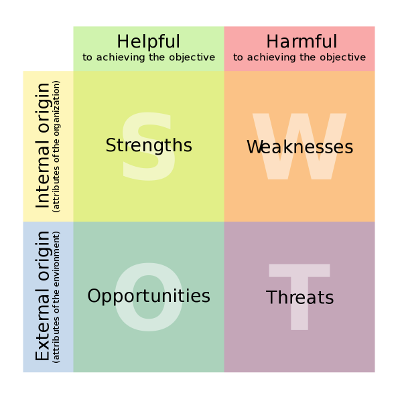We have previously discussed the importance of building your mobile app product strategy on a solid foundation. This means doing the fundamental tasks during the planning phase of your mobile app. It also means executing ongoing operational tasks as well. After collecting this data, you’re ready to make some big decisions. It is time to bring all your findings together into a comprehensive report. Doing a SWOT analysis for mobile apps is a great method to accomplish this crucial step.
Moreover, creating a SWOT document isn’t a done once and forget type of task. This file can be used as a reference when it is time to revisit priorities and risk. Regardless of what type of a mobile app project you are managing, the SWOT is a great tool for building out your product roadmap. For that reason, complete a SWOT to help identify when an app needs to be overhauled. On the other hand, it is also beneficial to learn if there are easy wins to be had. To have a more in-depth discussion, segment the SWOT into unique sections. Development, User Experience (UX), and marketing are distinct areas to drill down into for additional insight.
SWOT Included in Planning Phase
As an IT person involved in years of IT Projects, I can reflect upon several projects that were we rushed for one reason or another. This experience has reinforced that we should never underestimate the value of robust planning. Now I see lots of ideas for mobile apps. Some of these fall into categories, such as:
- Excellent original app ideas
- Ideas that re-brand existing solutions with a new spin
- Enterprises wanting to remake a legacy system on a mobile platform
- Companies promoting brand loyalty with a mobile app
Regardless of what the client desires, we review our program with them first. Despite the level of knowledge the customer has about mobile development, we communicate how to flush out their idea fully. We have learned the most satisfied customers are the ones that trust us. To build trust, we protect their capital. This means conserving time and money. As a result, we always advise conducting a SWOT analysis as part of the overall mobile app product strategy.
What is SWOT?
In the age of digital transformation, enterprises companies and startups alike are continually seeking to find a distinguishing feature or gain a competitive advantage. For that reason, SWOT has become a popular method used for evaluating Strengths, Weaknesses, Opportunities, and Threats. These are the four main areas involved in any mobile app project or business venture.
Corporate C-level executives, top management, and strategists are most likely aware of completing a SWOT analysis to understand a project thoroughly. In like manner, to gain approval from investors, SWOT is a key tool for telling a story. This is why every team member needs a good level of knowledge about contributing to the SWOT model when asked.
Benefits
SWOT is an abbreviation. Over time it has become a proper name with an implied meaning behind it. The letters stand for strength, weaknesses, opportunities, and threats. Essentially it is a simple framework for paining the bigger picture. It helps you focus on those four areas independent of one another. At the end of the analysis, the process generates a document that becomes a tool. The tool works as a means to identify not just internal but also external forces. It is precisely this vehicle that promotes healthy and optimal plans of action.
Time & Effort
Additionally, this tool doesn’t require any software license, nor is there any major training cost involved. There is only the investment of your time and effort. The best way to learn SWOT is by reviewing great examples and discussing them with your team.
- Use your creativity to think out of the box ideas
- Gain a deeper understanding of your business more deeply
- Be honest about your own weaknesses to avoid threats and failure
- Discuss and elaborate strengths to discover untapped opportunities
Conducting the analysis
- Define the objective. Select a key project or strategy to analyze. Place that text at the top of the page. Remember that you can segment major parts of a project. Break up the mobile app into the design, technology, and financial areas if that helps with decision making
- Create the squares. A SWOT diagram is simple. There is one large square that is divided equally into four equal smaller squares. Easily draw it out on a whiteboard or find a template online.
- Label the boxes. Start on the top left with the word “Strengths.” Inside the top right box goes “Weaknesses.” In the same order, complete the labels by writing “Opportunities” and “Threats.” These are the titles that guide the rest of the text you will generate to go inside each box.
- Fill out each area. The key is to focus on truly impactful items. Keep the text brief. Building out the text is a collaborative effort with as many team members as possible. Get a consensus for what text must be added. Strip off what the team doesn’t endorse. Add both quantitative and anecdotal material.
- Determine conclusions. Finishing the SWOT diagram is not the end of the exercise. Analyze the text. The critical factor will be accurate and objectively judging the squares. Get the group to decide if the positives in the first column outweigh the negatives in the second column. This is an excellent time to schedule a follow-up meeting for defining adjustments as needed.
Conducting the analysis
- Define the objective. Select a key project or strategy to analyze. Place that text at the top of the page. Remember that you can segment major parts of a project. Break up the mobile app into the design, technology, and financial areas if that helps with decision making
- Create the squares. A SWOT diagram is simple. There is one large square that is divided equally into four equal smaller squares. Easily draw it out on a whiteboard or find a template online.

- Label the boxes. Start on the top left with the word “Strengths.” Inside the top right box goes “Weaknesses.” In the same order, complete the labels by writing “Opportunities” and “Threats.” These are the titles that guide the rest of the text you will generate to go inside each box.
- Fill out each area. The key is to focus on truly impactful items. Keep the text brief. Building out the text is a collaborative effort with as many team members as possible. Get a consensus for what text must be added. Strip off what the team doesn’t endorse. Add both quantitative and anecdotal material.
- Determine conclusions. Finishing the SWOT diagram is not the end of the exercise. Analyze the text. The critical factor will be accurate and objectively judging the squares. Get the group to decide if the positives in the first column outweigh the negatives in the second column. This is an excellent time to schedule a follow-up meeting for defining adjustments as needed.
Summary
Never underestimate the impact of a SWOT session. It is a worthy effort because knowing a product’s strengths and weaknesses are required input for staying ahead in the market. Keep in mind that the SWOT analysis for mobile apps recommends which opportunities to chase and what threats to minimize. Ultimately, if you learn how to match strengths to opportunities, your on your way to defining your product’s strategic road map.




